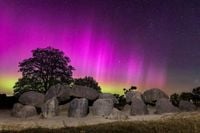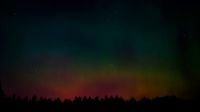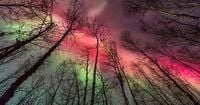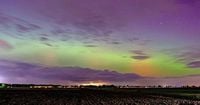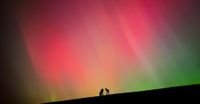The Northern Lights, a breathtaking natural phenomenon, may grace the skies of the Netherlands tonight, thanks to a powerful solar flare that is heading towards Earth. According to meteorological reports, the best time to catch a glimpse of this ethereal light show will be between 10:00 PM and 2:00 AM, spanning the night of March 23 to the early hours of March 24, 2025.
This solar flare, which erupted last Friday, usually takes two to three days to reach our atmosphere and can cause the mesmerizing auroras that many people hope to see. Meteorologists recommend that anyone interested in witnessing this spectacle should keep an eye on the skies during the designated hours, although it is notoriously challenging to predict exactly how bright the lights will be and when they will appear.
Jordi Huirne, a meteorologist with Hart van Nederland, emphasizes the uncertainty surrounding the visibility of the Northern Lights. While he states, "It’s always tricky to predict how strong the light will shine and at what times it will be exactly, but it's worth trying to stay up late this evening," he also acknowledges the variable nature of the event based on the solar particles' arrival time.
As excitement builds for tonight, it's important to note that weather conditions might complicate the view. The forecasts indicate cloud cover and possible showers, particularly in the northern and northeastern parts of the country, which could obstruct the line of sight to the aurora. Conversely, the middle and southern regions are expected to have a better chance of clear spells for observations.
Wouter van Bernebeek, another meteorologist, noted that, "The middle and south/southwest of the country have the best potential for clear skies tonight, although there will likely be some breaks in the cloud cover elsewhere." This means that while there may be opportunities to see the lights, they will depend heavily on luck and the timing of the solar flare's arrival.
To add a bit of scientific context, the Northern Lights occur during periods of heightened solar activity. Solar flares are powerful bursts of radiation from the sun, and when these bursts are directed towards Earth, they can collide with the Earth's magnetic field. These interactions produce beautiful particles that create the shimmering colors we see in auroras.
As we approach the evening hours, many social media users and news outlets are gearing up to share live updates and any sighting tips they gather. The public's enthusiasm is palpable, with many urging others to step outside and look up at the sky. Such community spirit amplifies the excitement surrounding this rare opportunity.
Based on past occurrences, the chances of seeing the Northern Lights have been quite favorable during previous solar storms. However, it is always accompanied by a level of unpredictability. While social media users reminisce about past displays, they also urge others to be prepared tonight. Expectations should be managed given the potential for less-than-ideal weather.
In conclusion, as night falls on March 23, 2025, and with the potential arrival of a solar flare, eyes will be turned skyward, hoping to catch a glimpse of the magnificent Northern Lights. For those who venture out to witness this spectacle, it's essential to bundle up, find a good vantage point away from city lights, and stay alert to the moment the sky may explode into a dance of color.
